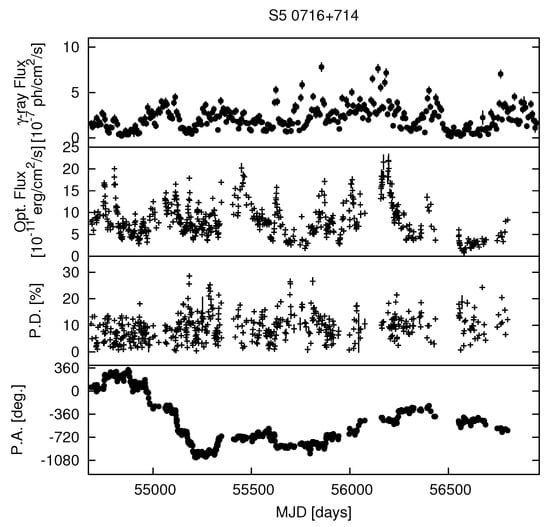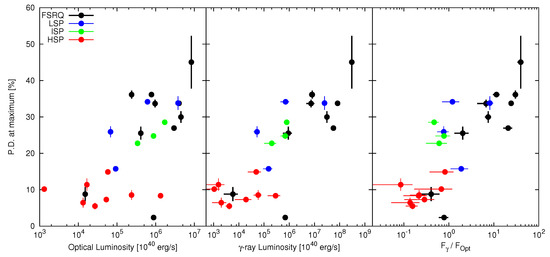Abstract
The polarization of relativistic jets is of interest for the understanding of their origin, confinement, and propagation. However, even though numerous measurements have been performed, the mechanisms behind jet variability, creation, and composition are still debated. We have performed simultaneous gamma-ray and optical photopolarimetry observations of 45 blazars with the Kanata telescope since July 2008 to investigate the mechanisms of variability and search for a basic relation between the several subclasses of relativistic jets. Consequently, we found that a correlation between the gamma-ray and optical flux might be related to gamma-ray luminosity, and the maximum polarization degree might be related to gamma-ray luminosity or the ratio of gamma-ray to optical flux. These results imply that low gamma-ray luminosity blazars emit from multiple regions.
1. Introduction
A relativistic jet is an extremely powerful fast outflow of plasma that emerges from the vicinity of massive black holes. Radio-loud active galactic nuclei (AGN) may possess relativistic jets, characterized by high kinetic powers (Lorentz factor ∼10) and large-scale structures (∼10 pc); however, the composition of jets and the mechanics underlying their formation are still a matter of much debate. The jets radiate at all wavebands, from radio to the gamma-ray regime via synchrotron and inverse Compton scattering processes. Polarized radiation from relativistic jets constitutes evidence of synchrotron radiation at low energies, and it also tends to vary drastically. The polarization of the jet is of interest for understanding the origin, confinement, and propagation of AGN jets. Recently, systematic study of this variability has been performed, with a focus on multi-wavelength and polarimetric observations among several subclasses of blazars (e.g., [1,2,3]). Reference [4] reported statistical photopolarimetric observations of blazars with a daily cadence using the Kanata telescope, and suggested that the lower luminosity and higher peak frequency of synchrotron radiation objects (such as HSP blazars) had smaller amplitudes of variation in flux, color, and polarization degree. In this study, we increased the number of observations and systematically searched for a common relationship between gamma-rays, optical flux, and polarization. We have been performing simultaneous optical photopolarimetry observations of 45 AGNs with the Kanata telescope since July 2008 in order to investigate the mechanisms of variability and search for a basic relation between several subclasses of blazars. We show recent results of polarimetric observations obtained by the Kanata telescope. Details of each observation are described in [5].
2. The Kanata Telescope and Observations of AGNs
The Kanata telescope is a 1.5-m-diameter telescope designed for optical and near-infrared observations at Higashi Hiroshima Observatory, Japan. The main targets of the Kanata telescope are gamma-ray bursts, AGNs, supernovae, X-ray binaries, cataclysmic variables, and any other optical transient objects. Owing to extensive observation time, we were able to perform temporally dense monitoring of AGNs. Two instruments were utilized for this purpose: TRISPEC and HOWPol, both of which are photopolarimeters. Forty-five AGNs were monitored daily for 6.5 years, beginning in 2008. Details of the observations and analyses are described in [6]. We selected gamma-ray bright blazars detected by Fermi-Large Area Telescope (LAT) instruments to obtain simultaneous observations in the optical and gamma-ray bands. All photo-polarimetric data are available from the CDS web server (http://vizier.u-strasbg.fr/viz-bin/VizieR-3?-source=J/ApJ/833/77).
3. Light Curves of AGNs
Here we show light curves obtained by our monitoring observations as an example. Figure 1 shows multi-wavelength light curves of blazar S5 0716 + 714. For S5 0716 + 714, gamma-ray flux, optical fluxes, and polarization show dramatic variability. We derived several parameters (e.g., the variability index and the correlation coefficient between flux and polarization) to compare the properties of different types of blazars. Our results showed that there are several types of variability among blazars. For example, 3C 454.3 shows a good correlation between optical flux and polarization degree, with a correlation coefficient of ∼0.73 ± 0.04. The significance of the correlation (95% C.L.) was tested using the block Bootstrap method (details of this method are described in Appendix A, [6]). In contrast, 3C 279 showed no clear correlation between optical flux and polarization degree (see [6]). The variability amplitudes of gamma-rays and optical flares in 3C 279 also differed from those in 3C 454.3. In [6], we discuss the origin of these differences among several types of blazars.

Figure 1.
Temporal variability of gamma-ray flux, optical flux, polarization degree (P.D.), and polarization angle (P.A.) for the source S5 0716 + 714. This figure is modified from [6].
4. Discussion
Figure 2 shows the distribution of variability indices of polarization degree calculated separately for each source. For the polarization degree variability index, we used the maximum observed polarization degree (PD) instead of PD = maximum PD − minimum PD, as most blazars show PD ∼ 0% during observation. The variability of maximum polarization degree appears to be correlated with gamma-ray luminosity and the ratio of gamma-ray and optical luminosities (correlation coefficient of 0.62∼0.68; Figure 2, right panels). This suggests that optical luminosity does not play an important role in blazar classification. We also examined the correlation between gamma-ray flux, optical flux, and polarization. Some blazars showed a significant correlation between gamma-ray and optical fluxes, as well as between the optical flux and polarization degree. In the case of correlation between gamma-ray and optical fluxes, about 15 out of 24 (∼63%) objects showed a significant correlation. In particular, 7 out of 11 FSRQ blazars and 8 out of 13 BL Lac objects presented a strong correlation. Details are reported in [6].

Figure 2.
From left to right, relations between the distribution of maximum polarization with respect to optical luminosity, gamma-ray luminosity, and the ratio of latter to the former. The black, blue, green, and red symbols indicate FSRQs, LSPs, ISPs, and HSPs , respectively. This figure is modified from [6].
Because the maximum polarization degree depends on the magnetic field condition, this result implies a systematic difference in the intrinsic alignment of magnetic fields in pc-scale relativistic jets between different types of blazars. A particular scenario that could explain our results is a spine-sheath model [7], in which the fast spine has ordered magnetic fields and the slow sheath has chaotic magnetic fields, as the maximum polarization degree depends on the condition of the magnetic field. In this scenario, the spine region would produce a highly variable and polarized synchrotron component, and the sheath region would produce a steady and weakly polarized component. Multiple emitting regions in blazars may be characterized by the distribution of electron energies varying from one region to another. If the number of emitting regions or the volume filling factor scales with , this could explain the lower effective polarization degree of BL Lacs (e.g., [8]). This predicts that the variability index scales with , and indeed there is some observational evidence that this is the case (e.g., [9]). To explain the systematic trend in maximum polarization degree, the jet volume fraction occupied by the spine should increase from the BL Lacs to the FSRQ blazars.
Acknowledgments
This work was supported by JSPS and NSF under the JSPS-NSF Partnerships for International Research and Education (PIRE). This work was also supported by JSPS KAKENHI Grant Numbers 24000004, 24244014.
Author Contributions
For manuscripts with more than one author, please state individual contributions of each author to research and writing of the manuscript.
Conflicts of Interest
The authors declare no conflicts of interest.
References
- Blinov, D.; Pavlidou, V.; Papadakis, I.; Kiehlmann, S.; Panopoulou, G.; Liodakis, I.; King, O.G.; Angelakis, E.; Baloković, M.; Das, H.; et al. RoboPol: first season rotations of optical polarization plane in blazars. Mon. Not. R. Astron. Soc. 2015, 453, 1669–1683. [Google Scholar] [CrossRef]
- Angelakis, E.; Hovatta, T.; Blinov, D.; Pavlidou, V.; Kiehlmann, S.; Myserlis, I.; Böttcher, M.; Mao, P.; Panopoulou, G.V.; Liodakis, I.; et al. RoboPol: the optical polarization of gamma-ray-loud and gamma-ray-quiet blazars. Mon. Not. R. Astron. Soc. 2016, 463, 3365–3380. [Google Scholar] [CrossRef]
- Jermak, H.; Steele, I.A.; Lindfors, E.; Hovatta, T.; Nilsson, K.; Lamb, G.P.; Mundell, C.; Barres de Almeida, U.; Berdyugin, A.; Kadenius, V.; et al. The RINGO2 and DIPOL optical polarization catalogue of blazars. Mon. Not. R. Astron. Soc. 2016, 462, 4267–4299. [Google Scholar] [CrossRef]
- Ikejiri, Y.; Uemura, M.; Sasada, M.; Ito, R.; Yamanaka, M.; Sakimoto, K.; Arai, A.; Fukazawa, Y.; Ohsugi, T.; Kawabata, K.S.; et al. Photopolarimetric Monitoring of Blazars in the Optical and Near-Infrared Bands with the Kanata Telescope. I. Correlations between Flux, Color, and Polarization. Publ. Astron. Soc. Jpn. 2011, 63, 639–675. [Google Scholar] [CrossRef]
- Itoh, R.; Tanaka, Y.T.; Fukazawa, Y.; Kawabata, K.S.; Kawaguchi, K.; Moritani, Y.; Takaki, K.; Ueno, I.; Uemura, M.; Akitaya, H.; et al. Minute-scale Rapid Variability of the Optical Polarization in the Narrow-line Seyfert 1 Galaxy PMN J0948+0022. Astrophys. J. Lett. 2013, 775, L26. [Google Scholar] [CrossRef]
- Itoh, R.; Nalewajko, K.; Fukazawa, Y.; Uemura, M.; Tanaka, Y.T.; Kawabata, K.S.; Madejski, G.M.; Schinzel, F.K.; Kanda, Y.; Shiki, K.; et al. Systematic Study of Gamma-ray-bright Blazars with Optical Polarization and Gamma-Ray Variability. Astrophys. J. Lett. 2016, 833, 77. [Google Scholar] [CrossRef]
- Ghisellini, G.; Tavecchio, F.; Chiaberge, M. Structured jets in TeV BL Lac objects and radiogalaxies. Implications for the observed properties. Astron. Astrophys. 2005, 432, 401–410. [Google Scholar] [CrossRef]
- Marscher, A.P.; Jorstad, S.G. Rapid Variability of Gamma-ray Emission from Sites near the 43 GHz Cores of Blazar Jets. arXiv, 2010; arXiv:astro-ph.CO/1005.5551. [Google Scholar]
- Aleksić, J.; Ansoldi, S.; Antonelli, L.A.; Antoranz, P.; Babic, A.; Bangale, P.; Barres de Almeida, U.; Barrio, J.A.; Becerra González, J.; Bednarek, W.; et al. Unprecedented study of the broadband emission of Mrk 421 during flaring activity in March 2010. Astron. Astrophys. 2015, 578, A22. [Google Scholar] [CrossRef]
© 2018 by the authors. Licensee MDPI, Basel, Switzerland. This article is an open access article distributed under the terms and conditions of the Creative Commons Attribution (CC BY) license (http://creativecommons.org/licenses/by/4.0/).